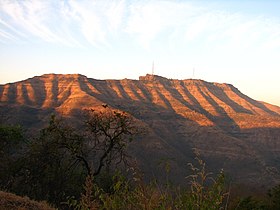Sinhagad
| Sinhgad- Kondhana | |
|---|---|

Sinhgad fort
|
|
| Highest point | |
| Elevation | 1,312 m (4,304 ft) |
| Coordinates | 18°21′56.39″N 73°45′18.97″E / 18.3656639°N 73.7552694°ECoordinates: 18°21′56.39″N 73°45′18.97″E / 18.3656639°N 73.7552694°E |
| Naming | |
| Translation | सिंहगड (Marathi) |
| Geography | |
| Location | Pune, Maharashtra, India |
| Parent range | Sahyadri Range |
Sinhagad, Sinhgarh, or Sinhgad (The Lion's Fort), is a fortress located roughly 30 kilometres southwest of the city of Pune, India. Previously called Kondhana (Marathi: कोंढाणा), the fort has been the site of many important battles, most notably the Battle of Sinhagad in 1671. It was also strategically located at the centre of a string of other forts such as Rajgad, Purandar and Torna.
Perched on an isolated cliff of the Bhuleswar range of the Sahyadri Mountains, it is situated on a hill rising some 760 metres above ground level and 1,312 metres above mean sea level. Given natural protection by its very steep slopes, the walls and bastions were constructed at only key places; it has two gates – the Kalyan Darwaza in the south-east and the Pune Darwaza in the north-east.
This fort has had quite a long history, It was called Kondana after the sage Kaundinya. The Kaundinyeshwar temple, the caves and the carvings indicate that this fort had probably been built two thousand years ago. It was captured from the Koli tribal chieftain, Nag Naik, by Muhammad bin Tughlaq in 1328 AD.
Shahaji Bhosale, as the commander of Ibrahim Adil Shah I, was entrusted with the control of the Pune region. His son Shivaji, however, refused to accept the Adilshahi and initiated the task of setting up Swarajya. He gained control of Kondana in 1647 by convincing Siddi Amber, the Adilshahi Sardar who controlled the fort, that he, the son of Shahaji Bhosale, could manage the fort's defences optimally. Bapuji Mudgal Deshpande played a key role in this activity. Adil Shah jailed Siddi Amber for this treasonous act, and schemed to get it back. He imprisoned Shahaji Bhosale for a concocted crime and informed Shivaji. In 1649, Adil Shah traded the fort for Shahaji's release. Shivaji Maharaj recaptured it in 1656, again with the help of Bapuji Mudgal Deshpande,who convinced the Fort commander by giving land in the newly created Shivapur village and peacefully gained control of the fort. This fort saw attacks by Mughals in 1662, 1663 and 1665. In 1664, Shahistekhan, the Mughal general, even tried to bribe the people of the fort to hand it over to him, but was unsuccessful. Through the Treaty of Purandar, it passed into the hands of the Mughal army chief Mirzaraje Jaysingh, in the year 1665. In 1670, Shivaji Maharaj re-conquered this fort and then it stayed under Maratha rule till 1689. After the death of Sambhaji, the Mughals regained control of the fort. The Marathas, headed by Sardar Balkawade, recaptured it in 1693. Chatrapati Rajaram took asylum on this fort during a Mogul raid on Satara but died on Sinhagad on 3 March 1700. In 1703 Aurangzeb conquered the fort. In 1706, it once again went into the hands of the Marathas. Pantaji Shivdev of Sangola, Visaji Chafar and the Pant Pratinidhis played key role in this battle. Then this fort remained with Marathas till 1818, when the British conquered it. British however took three months to capture this fort, which was longest it took them to win any fort in Maharashtra.
...
Wikipedia

